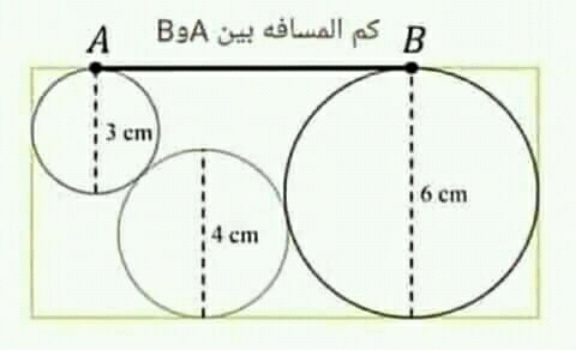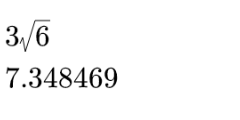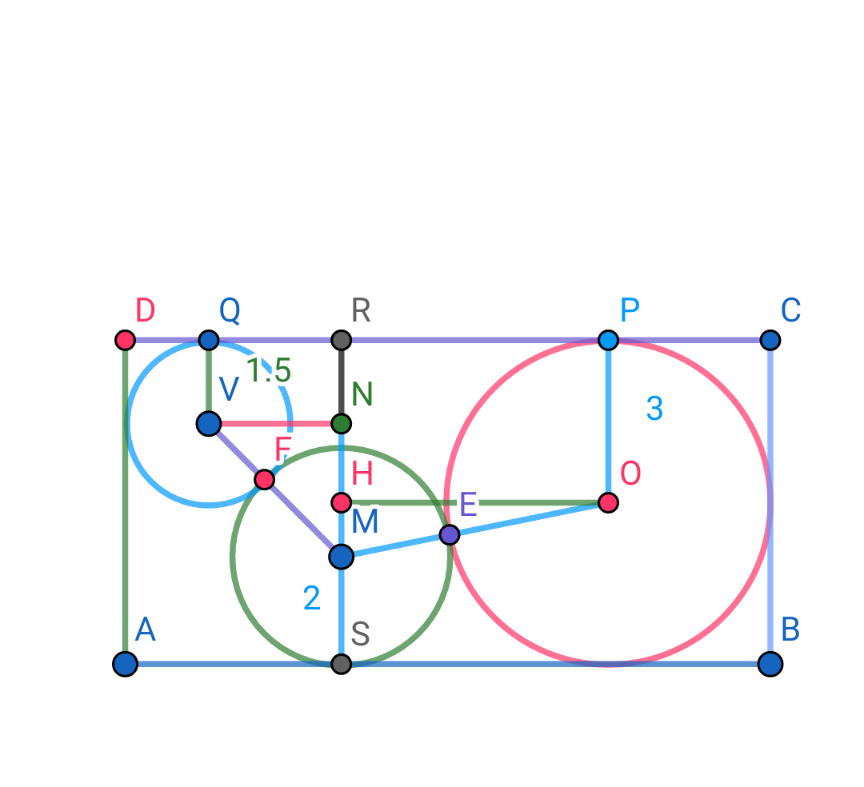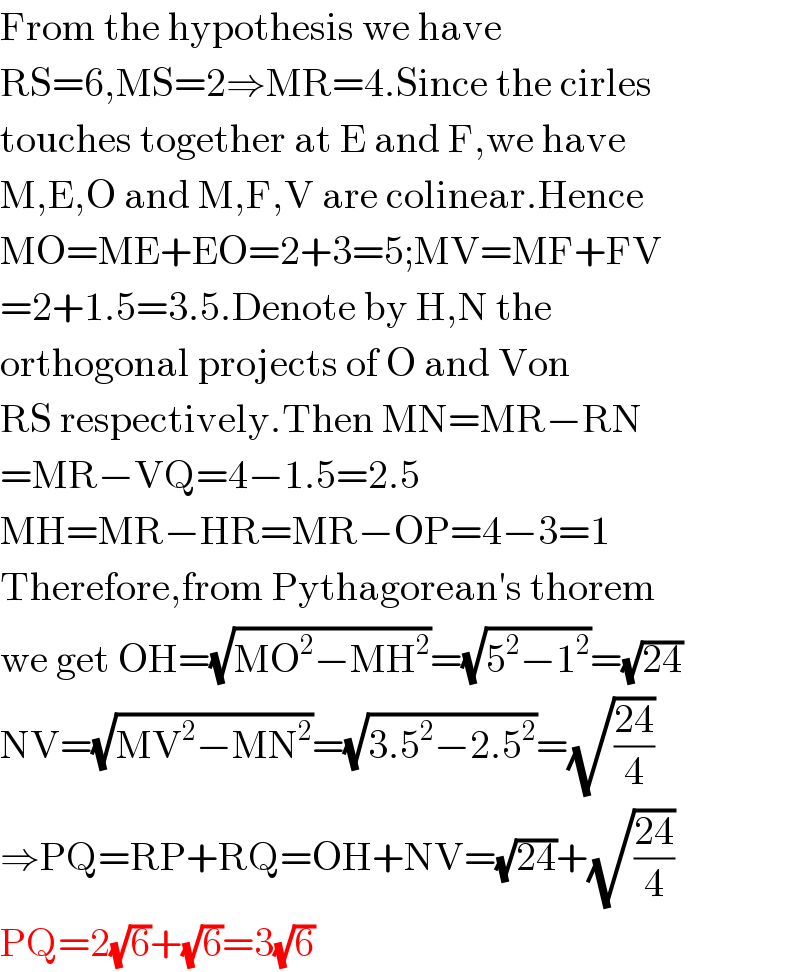
Question Number 116961 by malwan last updated on 08/Oct/20

Commented by malwan last updated on 08/Oct/20

$$\mid{AB}\mid=? \\ $$
Commented by bobhans last updated on 08/Oct/20

$$\mathrm{AB}=\sqrt{\mathrm{5}^{\mathrm{2}} −\left(\mathrm{3}−\mathrm{2}\right)^{\mathrm{2}} }\:+\:\sqrt{\mathrm{3}.\mathrm{5}^{\mathrm{2}} −\mathrm{2}.\mathrm{5}^{\mathrm{2}} } \\ $$$$=\:\sqrt{\mathrm{25}−\mathrm{1}}\:+\sqrt{\left(\mathrm{3}.\mathrm{5}+\mathrm{2}.\mathrm{5}\right)\left(\mathrm{3}.\mathrm{5}−\mathrm{2}.\mathrm{5}\right)} \\ $$$$=\sqrt{\mathrm{24}}\:+\sqrt{\mathrm{6}×\mathrm{1}}\:=\:\mathrm{2}\sqrt{\mathrm{6}}\:+\sqrt{\mathrm{6}}\:=\:\mathrm{3}\sqrt{\mathrm{6}\:} \\ $$
Commented by bobhans last updated on 08/Oct/20

Commented by malwan last updated on 08/Oct/20

$${thank}\:{you}\:{so}\:{much} \\ $$
Answered by 1549442205PVT last updated on 09/Oct/20

Commented by 1549442205PVT last updated on 09/Oct/20

$$\mathrm{From}\:\mathrm{the}\:\mathrm{hypothesis}\:\mathrm{we}\:\mathrm{have}\: \\ $$$$\mathrm{RS}=\mathrm{6},\mathrm{MS}=\mathrm{2}\Rightarrow\mathrm{MR}=\mathrm{4}.\mathrm{Since}\:\mathrm{the}\:\mathrm{cirles} \\ $$$$\mathrm{touches}\:\mathrm{together}\:\mathrm{at}\:\mathrm{E}\:\mathrm{and}\:\mathrm{F},\mathrm{we}\:\mathrm{have} \\ $$$$\mathrm{M},\mathrm{E},\mathrm{O}\:\mathrm{and}\:\mathrm{M},\mathrm{F},\mathrm{V}\:\mathrm{are}\:\mathrm{colinear}.\mathrm{Hence} \\ $$$$\mathrm{MO}=\mathrm{ME}+\mathrm{EO}=\mathrm{2}+\mathrm{3}=\mathrm{5};\mathrm{MV}=\mathrm{MF}+\mathrm{FV} \\ $$$$=\mathrm{2}+\mathrm{1}.\mathrm{5}=\mathrm{3}.\mathrm{5}.\mathrm{Denote}\:\mathrm{by}\:\mathrm{H},\mathrm{N}\:\mathrm{the} \\ $$$$\mathrm{orthogonal}\:\mathrm{projects}\:\mathrm{of}\:\mathrm{O}\:\mathrm{and}\:\mathrm{Von} \\ $$$$\mathrm{RS}\:\mathrm{respectively}.\mathrm{Then}\:\mathrm{MN}=\mathrm{MR}−\mathrm{RN} \\ $$$$=\mathrm{MR}−\mathrm{VQ}=\mathrm{4}−\mathrm{1}.\mathrm{5}=\mathrm{2}.\mathrm{5} \\ $$$$\mathrm{MH}=\mathrm{MR}−\mathrm{HR}=\mathrm{MR}−\mathrm{OP}=\mathrm{4}−\mathrm{3}=\mathrm{1} \\ $$$$\mathrm{Therefore},\mathrm{from}\:\mathrm{Pythagorean}'\mathrm{s}\:\mathrm{thorem} \\ $$$$\mathrm{we}\:\mathrm{get}\:\mathrm{OH}=\sqrt{\mathrm{MO}^{\mathrm{2}} −\mathrm{MH}^{\mathrm{2}} }=\sqrt{\mathrm{5}^{\mathrm{2}} −\mathrm{1}^{\mathrm{2}} }=\sqrt{\mathrm{24}} \\ $$$$\mathrm{NV}=\sqrt{\mathrm{MV}^{\mathrm{2}} −\mathrm{MN}^{\mathrm{2}} }=\sqrt{\mathrm{3}.\mathrm{5}^{\mathrm{2}} −\mathrm{2}.\mathrm{5}^{\mathrm{2}} }=\sqrt{\frac{\mathrm{24}}{\mathrm{4}}} \\ $$$$\Rightarrow\mathrm{PQ}=\mathrm{RP}+\mathrm{RQ}=\mathrm{OH}+\mathrm{NV}=\sqrt{\mathrm{24}}+\sqrt{\frac{\mathrm{24}}{\mathrm{4}}} \\ $$$$\mathrm{PQ}=\mathrm{2}\sqrt{\mathrm{6}}+\sqrt{\mathrm{6}}=\mathrm{3}\sqrt{\mathrm{6}}\: \\ $$
Commented by malwan last updated on 23/Oct/20

$${fantastic}\:{sir} \\ $$$${thank}\:{you} \\ $$
